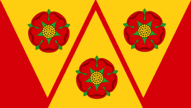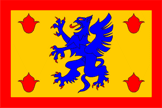![[Seal of Boulder]](../images/v/vxt-d4867.gif)
![[Seal of US State of Florida]](../images/v/vxt-d2340.gif)
![[Subotica, Serbia]](../images/v/vxt-d5376.gif)
Flag of Boulder, US;
State Seal of Florida;
Flag of Subotica, Serbia
Please note, that whilst a seal originally showed the user’s badge or parts of their armorial bearings (and was used to create an impression on wax or lead), when seen on flags today it is generally not (particularly in US usage) a coat of arms as defined herein (see also ‘anti-heraldry’).
![[Idaho, US]](../images/v/vxt-d346b.gif)
![[Seal of US Dept of Energy]](../images/v/vxt-d2140.gif)
![[Seal of US Census Bureau]](../images/v/vxt-d5028.gif)
Flag of Idaho, US;
Flag of the Dept of Energy, US; Flag of the
Census Bureau, US
Notes:
a) This term has been introduced by the Editors as being more appropriate than
those (sometimes) currently in use – see logo on a bedsheet
and seal on a bedsheet.
b) In US usage flags of his type are often derived from previously established military colours.
![[Flag of US state of New Hampshire]](../images/v/vxt-d4869.gif)
![[Seal of US state of Florida]](../images/v/vxt-d5377.gif)
![[Flag of US state of Kansas]](../images/v/vxt-d5029.gif)
Flags of the States of New Hampshire and
Kansas, and Seal of State of Minnesota, US
![[Morocco]](../images/v/vxt-d1049.gif)
![[Morocco]](../images/v/vxt-d1049a.gif)
National flag and Emblem of Morocco
2) As above, but the term may (albeit inaccurately) include flags bearing a coat of arms rather than a seal – see armorial flag.
![[New Hampshire, US]](../images/v/vxt-d346a.gif)
![[Minnesota, US]](../images/v/vxt-d2521.gif)
![[New York, US]](../images/v/vxt-d346c.gif)
Flag of
New Hampshire, US; Flag of Minnesota, US;
Flag of New York, US
![[heraldic beast]](../images/v/vxt-d4563.gif)
![[sea-lion]](../images/v/vxt-d4151.gif)
![[sea-lion]](../images/v/vxt-d5074.gif)
Flag of Varaždinske Toplice, Croatia;
Arms of Portsmouth, UK;
Presidential Flag of the Philippines
![[second colour]](../images/v/vxt-d2363.gif)
Second/Regimental Colour of the Governor General’s Foot Guards, Canada (official website)
2) See ‘gyronny’.
![[sectors example]](../images/v/vxt-d5409.gif)
![[sectors example]](../images/v/vxt-d4632.gif)
![[sectors example]](../images/v/vxt-d4631.gif)
Civil Jack,
Aircraft Roundel and
Naval Jack of The Netherlands
![[sector flag example]](../images/v/vxt-d472.gif)
Sector/Registration flag, One Department of Rochefort, France
2) In vexillology a term that may be used in place of the heraldic “gyronny” when a charge or field is divided into sections in (usually) alternating or different shades/colours meeting at a central point – but see ‘gyronny’.
![[sectored example]](../images/v/vxt-d1021a.gif)
![[sectored example]](../images/v/vxt-d1021b.gif)
![[sectored example]](../images/v/vxt-d4633.gif)
Flag of Gornji Grad, Slovenia;
Symbol of the Ratana faith, New Zealand;
Flag of Schellerten, Germany
![[seeded example]](../images/v/vxt-d3909.gif)
![[seeded example]](../images/v/vxt-d3907.gif)

Flag of Hampshire, UK;
Flag of Lancashire and of
Lancashire CC
Please note that botany draws a distinction between the stamen and seedpods of a rose or other flower, whereas English heraldry does not.
![[segmented example]](../images/v/vxt-d1408.gif)
![[segmented example]](../images/v/vxt-d3407.gif)
Flag of Mollis, Switzerland; Flag of
Balneário Camboriú, Brazil
![[segreant example]](../images/v/vxt-d1080.gif)

Military Crest of Michigan, US; Flag of
Boksburg, South Africa 1981–1994
Please note that the visual difference between sejant and couchant is often
difficult to determine, and we suggest that the official blazon be followed in each
individual case.![[sejant example]](../images/v/vxt-d5465.gif)
![[sejant example]](../images/v/vxt-d5466.gif)
![[sejant example]](../images/v/vxt-d5467.gif)
Flag of Villarsel-sur-Marly, Switzerland;
Flag of Škabrnja, Croatia;
Flag of Sobrio, Switzerland

![[second canton]](../images/v/vxt-d1576b.gif)
![[selvedge example]](../images/v/vxt-d1275.gif)